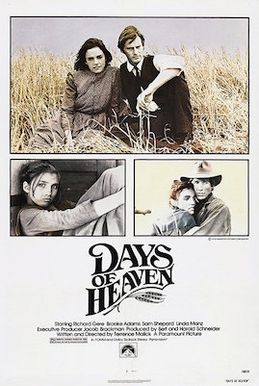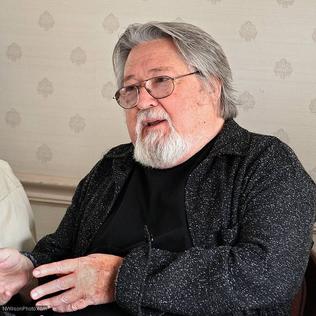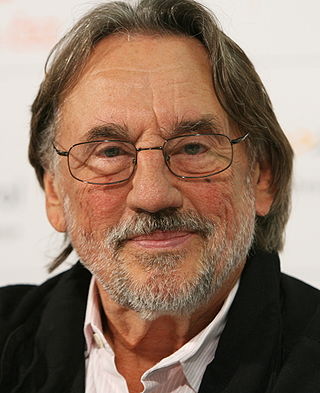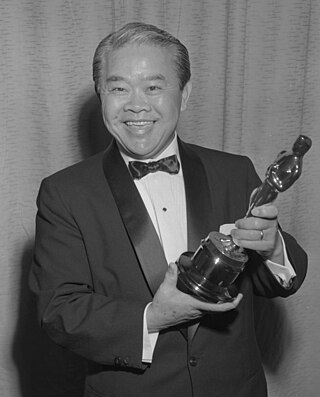
Days of Heaven is a 1978 American romantic period drama film written and directed by Terrence Malick, and starring Richard Gere, Brooke Adams, Sam Shepard and Linda Manz. Set in 1916, it tells the story of Bill and Abby, lovers who travel to the Texas Panhandle for work harvesting crops for a wealthy grain farmer. Bill persuades Abby to claim the fortune of the dying farmer by tricking him into a sham marriage. The scheme soon devolves into an Old Testament parable that threatens to destroy the lives of everyone involved.

László KovácsASC was a Hungarian-American cinematographer who was influential in the development of American New Wave films in the 1970s, collaborating with directors including Peter Bogdanovich, Richard Rush, Dennis Hopper, Norman Jewison, and Martin Scorsese. Known for his work on Easy Rider (1969) and Five Easy Pieces (1970), Kovács was the recipient of numerous awards, including three Lifetime Achievement Awards. He was an active member of the American Society of Cinematographers and was a member of the organization's board of directors.

American Cinematographer is a magazine published monthly by the American Society of Cinematographers. It focuses on the art and craft of cinematography, covering domestic and foreign feature productions, television productions, short films, music videos and commercials.

Vilmos Zsigmond was a Hungarian-American cinematographer. His work in cinematography helped shape the look of American movies in the 1970s, making him one of the leading figures in the American New Wave movement.

Wong Tung Jim, A.S.C. (Chinese: 黃宗霑; August 28, 1899 – July 12, 1976), known professionally as James Wong Howe (Houghto), was a Chinese-born American cinematographer who worked on over 130 films. During the 1930s and 1940s, he was one of the most sought after cinematographers in Hollywood due to his innovative filming techniques. Howe was known as a master of the use of shadow and one of the first to use deep-focus cinematography, in which both foreground and distant planes remain in focus.

Charles G. Rosher, A.S.C. was an English-born cinematographer who worked from the early days of silent films through the 1950s.
Frederick A. YoungOBE, BSC was an English cinematographer. Sometimes credited as F. A. Young, his career in motion picture photography spanned more than 130 films across nearly 70 years, between 1919 and 1984. He was best known for the sweeping, lush widescreen color photography he displayed through his collaborations with director David Lean. He won the Academy Award for Best Cinematography three times - for Lawrence of Arabia (1962), Doctor Zhivago (1965) and Ryan's Daughter (1970) - all directed by Lean.
Néstor Almendros Cuyás, ASC was a Spanish cinematographer. One of the most highly appraised contemporary cinematographers, "Almendros was an artist of deep integrity, who believed the most beautiful light was natural light...he will always be remembered as a cinematographer of absolute truth...a true master of light".
James Bertrand Longley is an American filmmaker.

Lee Garmes, A.S.C. was an American cinematographer. During his career, he worked with directors Howard Hawks, Max Ophüls, Josef von Sternberg, Alfred Hitchcock, King Vidor, Nicholas Ray and Henry Hathaway, whom he had met as a young man when the two first came to Hollywood in the silent era. He also co-directed two films with legendary screenwriter Ben Hecht: Angels Over Broadway and Actors and Sin.

Arthur Edeson, A.S.C. was an American cinematographer. Born in New York City, his career ran from the formative years of the film industry in New York, through the silent era in Hollywood, and the sound era there in the 1930s and 1940s. His work included many landmarks in film history, including The Thief of Bagdad (1924), All Quiet on the Western Front (1930), Frankenstein (1931), The Maltese Falcon (1941), and Casablanca (1942).

Easy Riders, Raging Bulls: How the Sex-Drugs-and-Rock 'N Roll Generation Saved Hollywood is a book by Peter Biskind, published by Simon & Schuster in 1998, about ostensibly the 1960s and 1970s Hollywood, a period of American film known for the production of such films such as The Godfather,The Godfather Part II,The French Connection,Chinatown,Taxi Driver,Jaws,Star Wars,The Exorcist, and The Last Picture Show. The title is taken from films which bookend the era: Easy Rider (1969) and Raging Bull (1980).

Arthur Charles Miller, A.S.C. was an American cinematographer. He was nominated for the Oscar for Best Cinematography six times, winning three times: for How Green Was My Valley in 1941, The Song of Bernadette in 1944, and Anna and the King of Siam in 1947.
Cinematographer Style is a 2006 American documentary film directed by Jon Fauer, ASC, about the art of cinematography. In the film, Fauer interviews 110 leading cinematographers from around the world, asking them about their influences and the origins of the style of their films.

John Ira BaileyASC was an American cinematographer and film director known for his collaborations with directors Paul Schrader, Lawrence Kasdan, Michael Apted, and Ken Kwapis. In August 2017, Bailey was elected president of the Academy of Motion Picture Arts and Sciences. He was succeeded by casting director David Rubin in August 2019.
Philippe Rousselot, AFC, ASC is a French cinematographer and film director best known for his wide range of work in both European and mainstream American cinema, ranging in genres from drama, to fantasy, to blockbusters. He has collaborated with directors such as Robert Redford, Neil Jordan, Stephen Frears, Tim Burton, David Yates, and Guy Ritchie. He is the recipient of three César Awards, a BAFTA, an Oscar, and is a nominee for the Palme d'Or.

Bert Lawrence Glennon was an American cinematographer and film director. He directed Syncopation (1929), the first film released by RKO Radio Pictures.

No Subtitles Necessary: Laszlo & Vilmos is a 2008 American documentary film written and directed by James Chressanthis.
The National Society of Film Critics Award for Best Cinematography is an annual award given by National Society of Film Critics to honor the best cinematographer of the year.

Rojek is a 2022 Canadian documentary film written, directed and produced by Zaynê Akyol. It is about the recovery of Kurdistan from the Rojava–Islamist conflict with a special emphasis on interviews with imprisoned former members of the Islamic State about their motivations. It was selected as the Canadian entry for the Best International Feature Film at the 96th Academy Awards.














